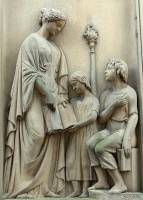 Education sculpture.
Education sculpture.
Statues emblematic of Education are widespread in Victorian and Edwardian sculpture, most typically adorning public buildings such as Town Halls, recognising the local authority duties to provide education, and on schools and colleges. The picture above is typical: Education is depicted as a female figure displaying an open book to two poor students. She is a mature woman rather than a youthful girlish figure, and is fully draped, as befits the conception of a Victorian teacher, and her hair is tied back, emphasising the idea of control. The pupils are poor, as shown by their ragged clothes and bare feet, for this is a philanthropic ideal of Education. Behind the group is a tall lamp, the burning light of knowledge.
Education statues in spandrels (triangular shapes above arches).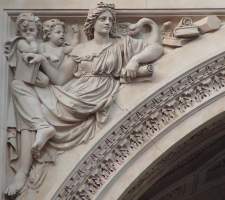
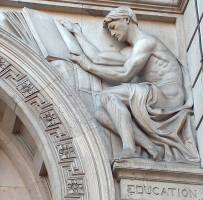
Here are a pair of spandrel figures representing Education, or at least one of them certainly does. The girl on the left, however, may represent Knowledge (see this page). She is draped, if lightly, and carries as well as the book, a scroll in her other hand. According to this interpretation, The two cherubic figures would be the students, and by convention, are somewhat light-hearted in nature, thus the earnest attention of the boy at the top of the page is here converted to the restlessness of one cherub and the bored pose of the other, resting his elbow on the book (if you like cherub sculpture, see this page). Further books and a scroll are in the background, and a swan – which if the attribution as Education is correct, is not here with connotations of Leda, but probably Apollo, and hence light (of knowledge). Statues of Education are more usually female, but to the right is a male example, with a large book, held open by two pointing fingers. Unusually, the Classical figure is almost nude (the students on the other hand are often without clothes; see comment at bottom of page).
More Education allegory as relief sculpture above arches.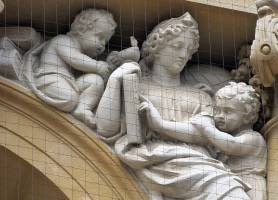
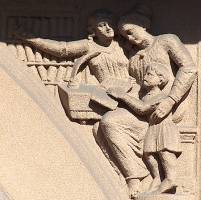
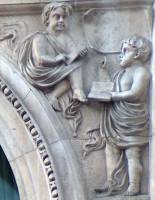
Three more examples of spandrel figures emblematic of Education. She to the left, above, has the now familiar book, is properly dressed, and has two cherubic figures gathered against her; one looks attentively while clutching the elbow of the arm whose hand gestures to the page, the other holding a small lamp. Further books are stacked behind, not regularly, for the idea is of books in constant use, dumped carelessly down as they will quickly be picked up again. The central picture shows a group consisting of a woman holding a small child, who has a book open on the lap of the Classical figure of Education behind. She has a desk with quill pen, and in the background is a shelf of books, Much decayed, but nicely composed and still epitomising the educational ideal. Then to the right is a purely cherubic example, with a pair of plump toga wearing cherubs holding books and making appropriate gestures; as previously, these are somewhat tongue in cheek, shown by the Bacchus-like figures and their expressions, which are anything but serious.
Sculptural friezes with several figures.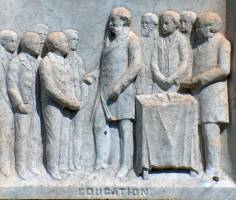
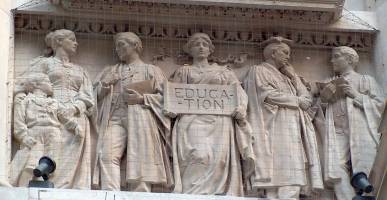
Groups now. The sculptural frieze above left is a panel at the base of a statue of a late Victorian philanthropist, and shows him as provider of education. He appears to be demonstrating something, for on the covered table behind him is some assortment of apparatus, alas, too worn to see what it is but perhaps something electrical; our man is declaiming to a group of schoolboys, serious-faced and attentively listening, the one in front with his hands clasped in front of him in an attitude of respect. Behind, a supporting group of acolytes. The picture above right, one of a series of sculptural friezes from the Institute of Chartered Accountants in Swan Alley in the City of London, shows a whole group of figure sculpture emblematic of education. The central figure, classically draped and holding the plaque, is intended as the embodiment of Education. To the viewer’s left, a man, broad of chest and wearing a graduate’s robe, cuts a figure of authority, and carries resting on his arm a book, helpfully entitled ‘Latin Primer’. He is shown declaiming to the school-marmish matron holding the boy with the cricket bat who is the intended audience. Looking at her grip on his shoulder and arm, we might think the youngster was anxious to get away to his game of cricket. To the right of the central figure are a further pair of scholarly men, in doctor’s robes, and the one wearing a mortar board. He is resting his cheek against his hand, the elbow of that arm supported by his other hand, frowning, as if deeply concentrating on the words of his fellow, a younger man reading from an open book. We may note that despite their attitudes of speech, their mouths are closed, or almost so, for with a statue in Classical vein, no matter if dressed in modern clothing, an open mouth would not be quite right.
Free standing statues emblematic of Education.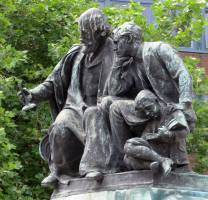
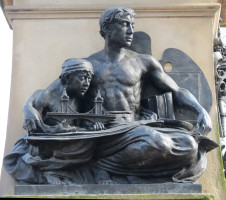
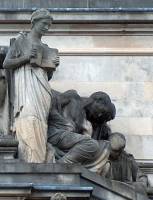
Full figure free-standing groups of statues now. Above left is the Education group of the Queen Victoria Memorial, Liverpool, by the sculptor C. J. Allen. Again, we have a male figure of Education, as an older man, hence more authoritative, wearing the scholarly robes we have seen in the friezes, and here holding a Bunsen burner. A student, head resting on hand in the by now familiar contemplative pose, looks at this, an open sheaf of papers resting on his knee. He has his spare hand on the shoulder of a smaller boy, curled up at his feet and reading from a book. The picture above centre shows part of Birmingham’s monument to Edward VII, with the male figure of Education showing a blueprint to the boy holding a bridge section (he represents Progress rather than just a pupil here); the background includes a row of books, and a palette indicative of education in the fine arts. The group above right has the emblematic figure of Education as a standing female, in the usual Classical robes and with serious face, holding open a book in both hands – it is this holding of a book for someone else to read, or gesturing towards it, which distinguishes figures of Education from those which are simply allegorical figures of Reading. To the right, a group of boys, reading together.
Here we have two allegorical groups each consisting of a single standing female figure of Education, each with a child emblematic of the student. To the left, one of the beautiful figures by Alfred Drury on Vauxhall Bridge, London (see this page for pictures of all the rest). As ever, a more mature woman, here heavily robed, and with the boy in front carrying a book – this really is at the emblematic rather than illustrative end of the spectrum, for rather than showing him the book, she is holding his arm, guiding him along the path of Education. The naked infant on her other, crooked arm is symbolic of Education starting from the youngest age. A most noble conception. And above right, to give a complete contrast, is a 1930s concept of Education, with the Classically-robed female figure, very Art Deco, holding a scroll, while at her feet a little girl has her arms raised in an attitude of the excitement of learning. Alfred Hardiman is the sculptor, and this work, with two others, is on the rear wall of the Norwich Town Hall (see this page for picture).
Finally, below, we return to where we started, a frieze showing in low relief a woman reading to a child. I think the nudity of the pupil in this and some of the other examples is indicative that they are early on the path of learning, unclothed in knowledge as it were. The frieze is much damaged, yet we would not need the title at the top to tell us that this was a representation of Education, so firm is the allegory.
Back to Allegorical sculpture - D // Forwards to Allegorical sculpture - F // Full Alphabet of Allegorical sculpture
Sculpture in London // Sculpture in England // Sculptors
Visits to this page from 10 May 2015: 8,727